A Study on the Sensitivities of an Ice Protection System Combining Thermoelectric and Superhydrophobic Coating to Icing Environment Parameters
Abstract
:1. Introduction
2. Experimental Methodology
2.1. Experimental Setup
2.2. Test Model
2.3. Test Conditions
2.4. Test Procedure and Temperature Processing Method
3. Results and Discussion
3.1. Sensitivity to Icing Environment Parameters
3.1.1. MVD
3.1.2. LWC
3.1.3. Environment Temperature
3.2. IPS Parameters Effect
3.2.1. Heating Range and Powers
3.2.2. Coating Range
3.2.3. Water Fall-off Position
4. Conclusions
- IPS with a coating prevented runback ice formation and reduced the power consumption by more than 50% compared to IPS with no coatings.
- IPS is highly sensitive to environment temperature. A designed IPS might not work well when environment temperature is beyond the design point.
- IPS is sensitive to MVD which determines the area that needs to be protected and is less sensitive to LWC. Nonetheless, increased MVD and LWC at the same time may demand enhancing the IPS’s heating power.
- The droplet impingement area is where the superhydrophobic coating works. The coating cannot promote all the water falling off when situated outside the impingement area. Therefore, the superhydrophobic coating needs to cover the droplet impingement area only.
- Sufficient heating power is required to keep the surface temperature of the superhydrophobic coating above the freezing point. Effective heat distribution on the surface is critical to IPS design.
Author Contributions
Funding
Data Availability Statement
Acknowledgments
Conflicts of Interest
References
- Thomas, S.K.; Cassoni, R.P.; MacArthur, C.D. Aircraft Anti-Icing and De-Icing Techniques and Modeling. J. Aircr. 1996, 33, 841–854. [Google Scholar] [CrossRef]
- Papadakis, M.; Wong, S.H. Parametric Investigation of a Bleed Air Ice Protection System. In Proceedings of the 44th AIAA Aerospace Sciences Meeting and Exhibit, Reno, NV, USA, 9–12 January 2006; p. 1013. [Google Scholar]
- Wright, W.B.; Keith, T.G. Numerical Simulation of Icing, Deicing and Shedding. In Proceedings of the 29th Aerospace Sciences Meeting, Reno, NV, USA, 7–10 January 1991; p. 665. [Google Scholar]
- Alegre, N.; Hammond, D. Experimental Setup for the Study of Runback Ice at Full Scale. J. Aircr. 2011, 48, 1978–1983. [Google Scholar] [CrossRef]
- Gent, R.W.; Ford, J.M.; Miller, D.R. SLD Research in the UK; SAE International: Montreal, QC, Canada, 2003. [Google Scholar]
- Rosen, K.M.; Potash, M.L. 40 years of helicopter ice protection experience at Sikorsky Aircraft. In Proceedings of the AIAA 19th Aerospace Sciences Meeting, St. Louis, MO, USA, 12–15 January 1981. [Google Scholar]
- Fortin, G.; Beisswenger, A.; Perron, J. Centrifuge Adhesion Test to Evaluated Icephobic Coatings. In Proceedings of the 2nd Atmospheric and Space Environment, Toronto, ON, Canada, 2–5 August 2010. [Google Scholar]
- Laforte, C.; Beisswenger, A. Icephobic Material Centrifuge Adhesion Test. In Proceedings of the 11th International Workshop on Atmospheric Icing on Structures, Montreal, QC, Canada, 12–16 June 2005. [Google Scholar]
- Fortin, G.; Perron, J. Spinning Rotor Blade Tests in Icing Wind Tunnel, American Institute of Aeronautics and Astronautics. In Proceedings of the 1st Atmospheric and Space Environment, San Antonio, TX, USA, 22–25 June 2009. [Google Scholar]
- Kimura, S.; Yamagishi, Y.; Sakabe, A.; Adachi, T.; Shimanuki, M. A new surface coating for prevention of icing on airfoils. In Proceedings of the SAE Aircraft and Engine Icing International Conference, Seville, Spain, 24–27 September 2007. [Google Scholar]
- Cao, L.; Jones, A.K.; Sikka, V.K.; Wu, J.; Gao, D. Anti-icing superhydrophobic coatings. Langmuir 2009, 25, 12444–12448. [Google Scholar] [CrossRef] [PubMed]
- Antonini, C.; Innocenti, M.; Horn, T.; Marengo, M.; Amirfazli, A. Understanding the effect of superhydrophobic coating on energy reduction in anti-icing systems. Cold Reg. Sci. Technol. 2011, 67, 58–67. [Google Scholar]
- Mangini, D.; Antonini, C.; Marengo, M.; Amirfazli, A. Runback Ice Formation Mechanism on Hydrophilic and Superhydrophobic Surfaces. Cold Reg. Sci. Technol. 2015, 109, 53–60. [Google Scholar] [CrossRef]
- Yin, L.; Zhu, L.; Wang, Q.; Ding, J.; Chen, Q. Superhydrophobicity of Natural and Artificial Surfaces under Controlled Condensation Conditions. ACS Appl. Mater. Interfaces 2011, 3, 1254–1260. [Google Scholar] [CrossRef] [PubMed]
- Fortin, G.; Adomou, M.; Perron, J. Experimental Study of Hybrid Anti-Icing Systems Combining Thermoelectric and Hydrophobic Coatings; SAE International: Montreal, QC, Canada, 2011. [Google Scholar]
- De Pauw, D.; Dolatabadi, A. Effect of Superhydrophobic Coating on the Anti-Icing and Deicing of an Airfoil. J. Aircr. 2017, 54, 490–499. [Google Scholar] [CrossRef]
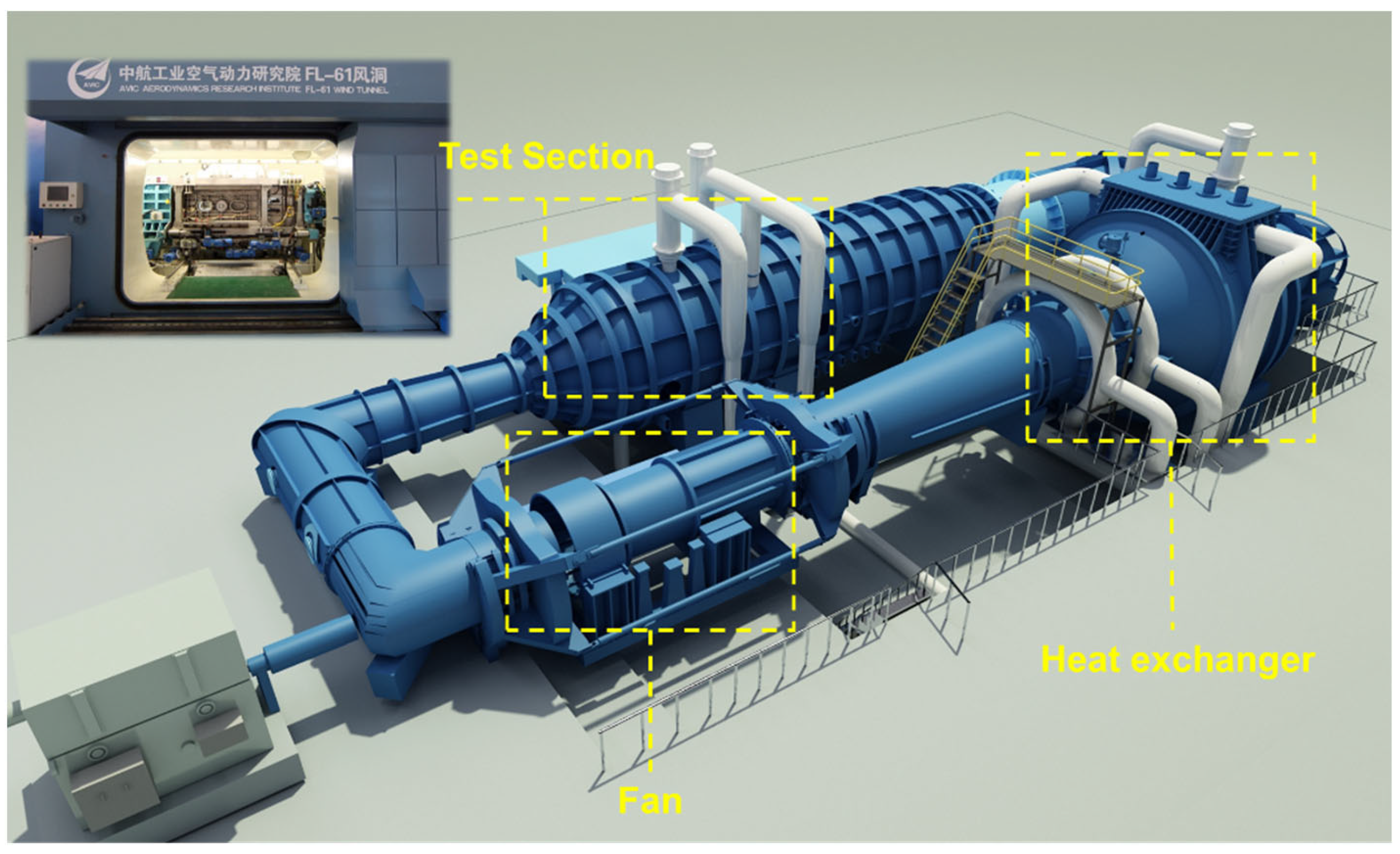

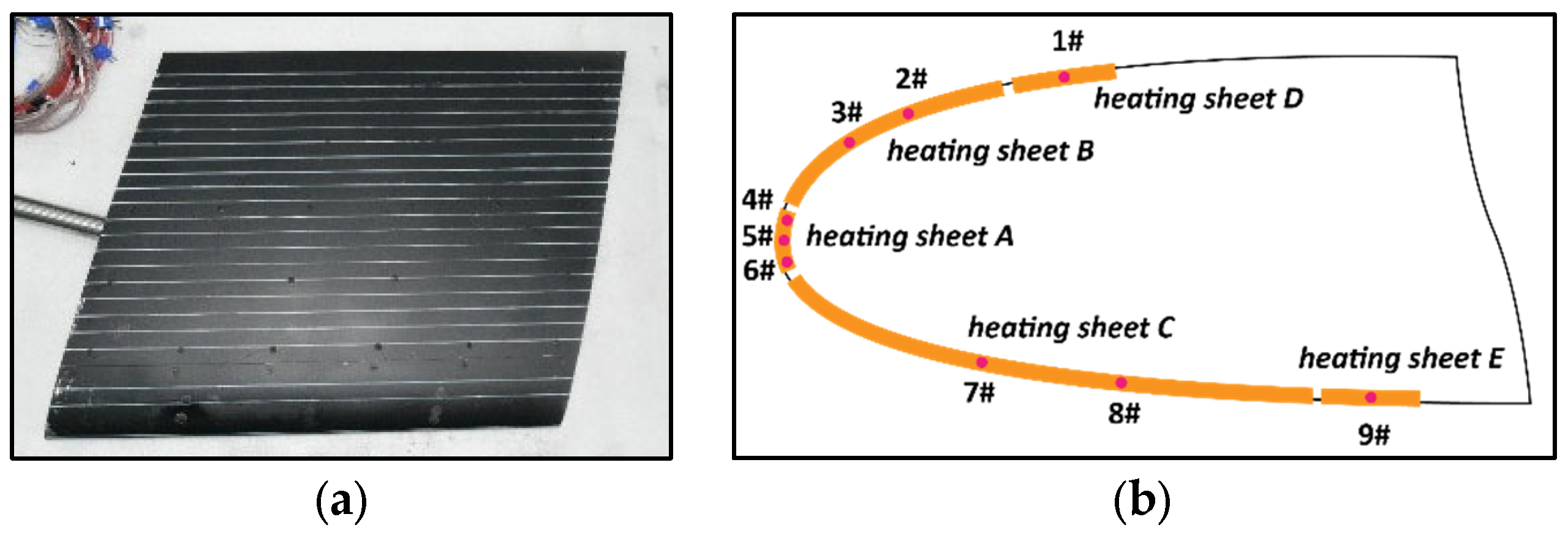

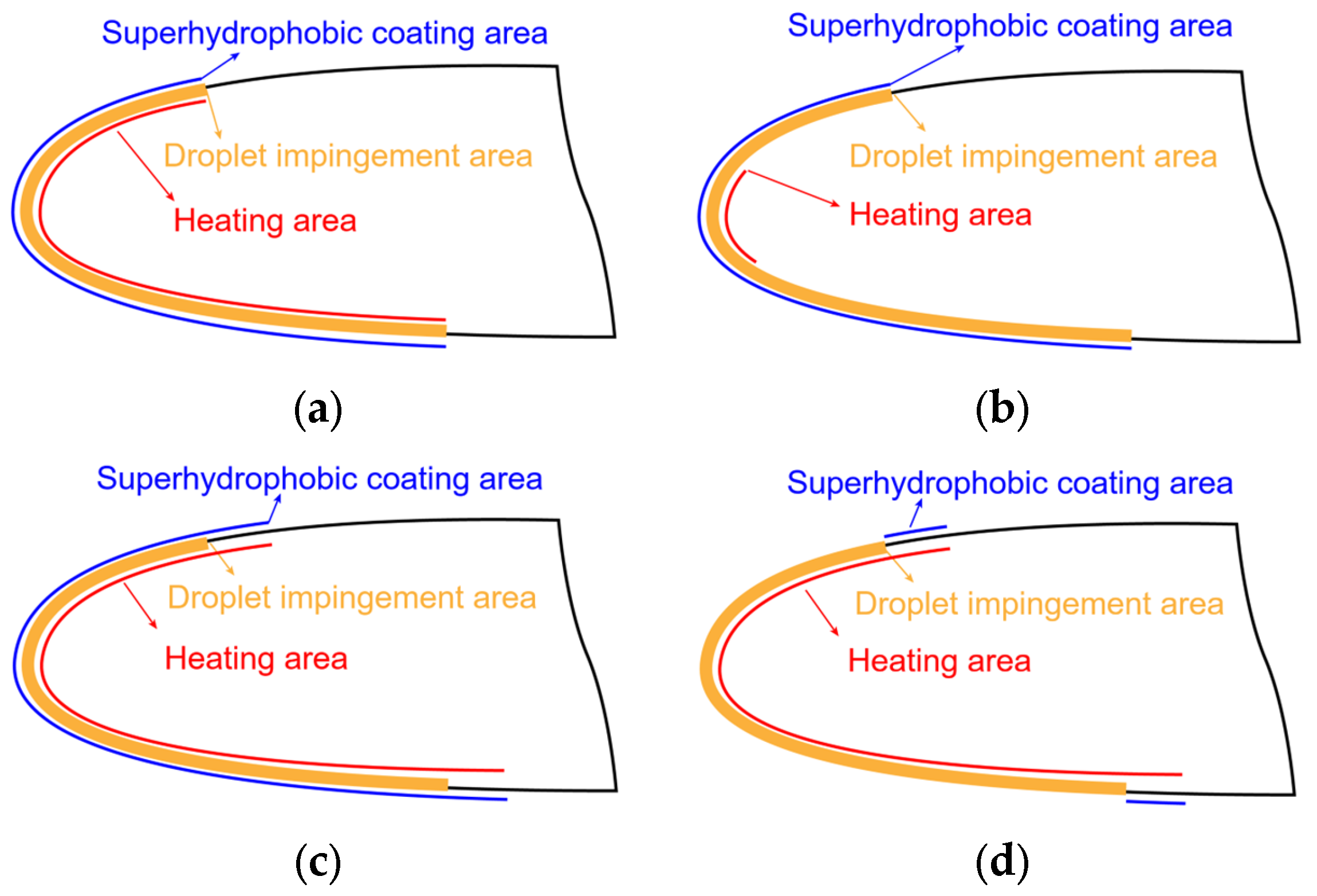
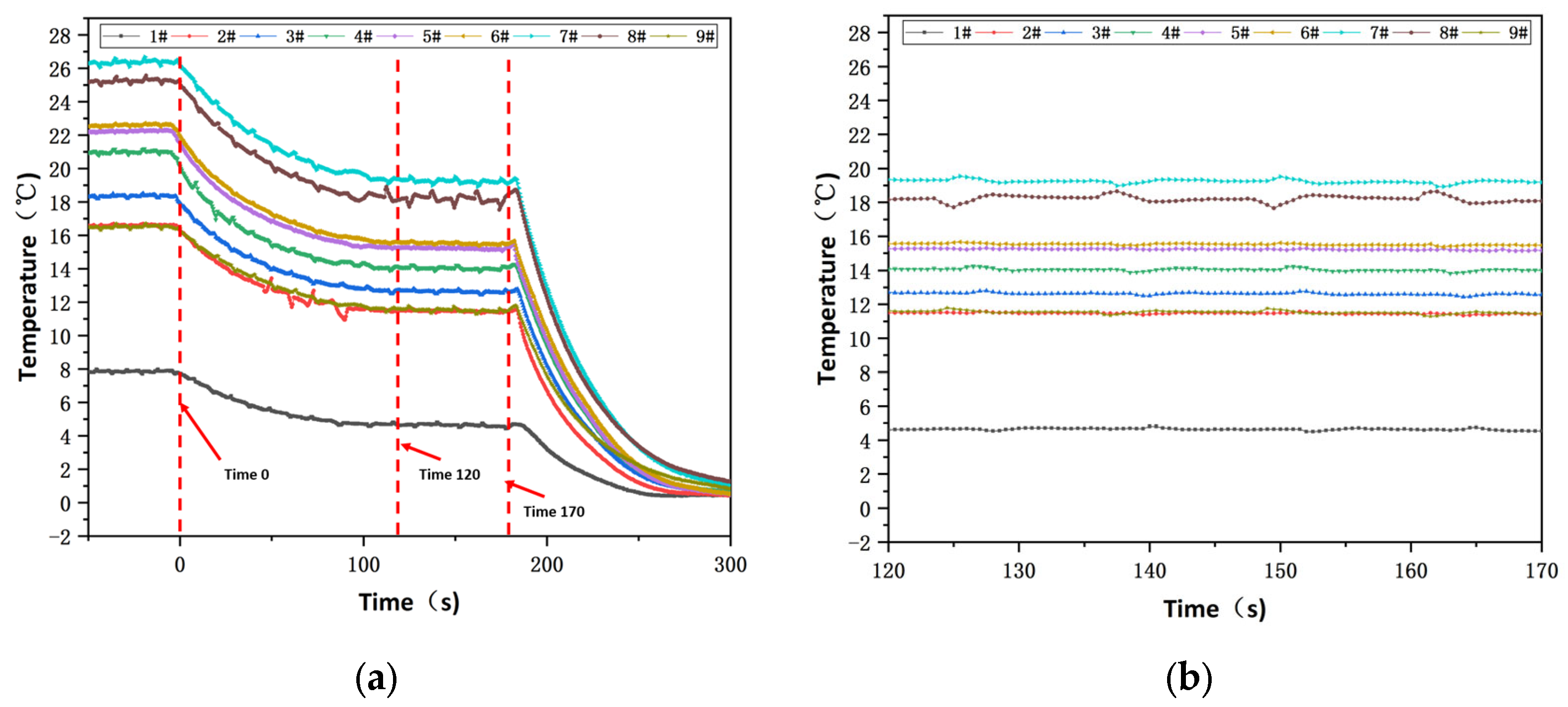




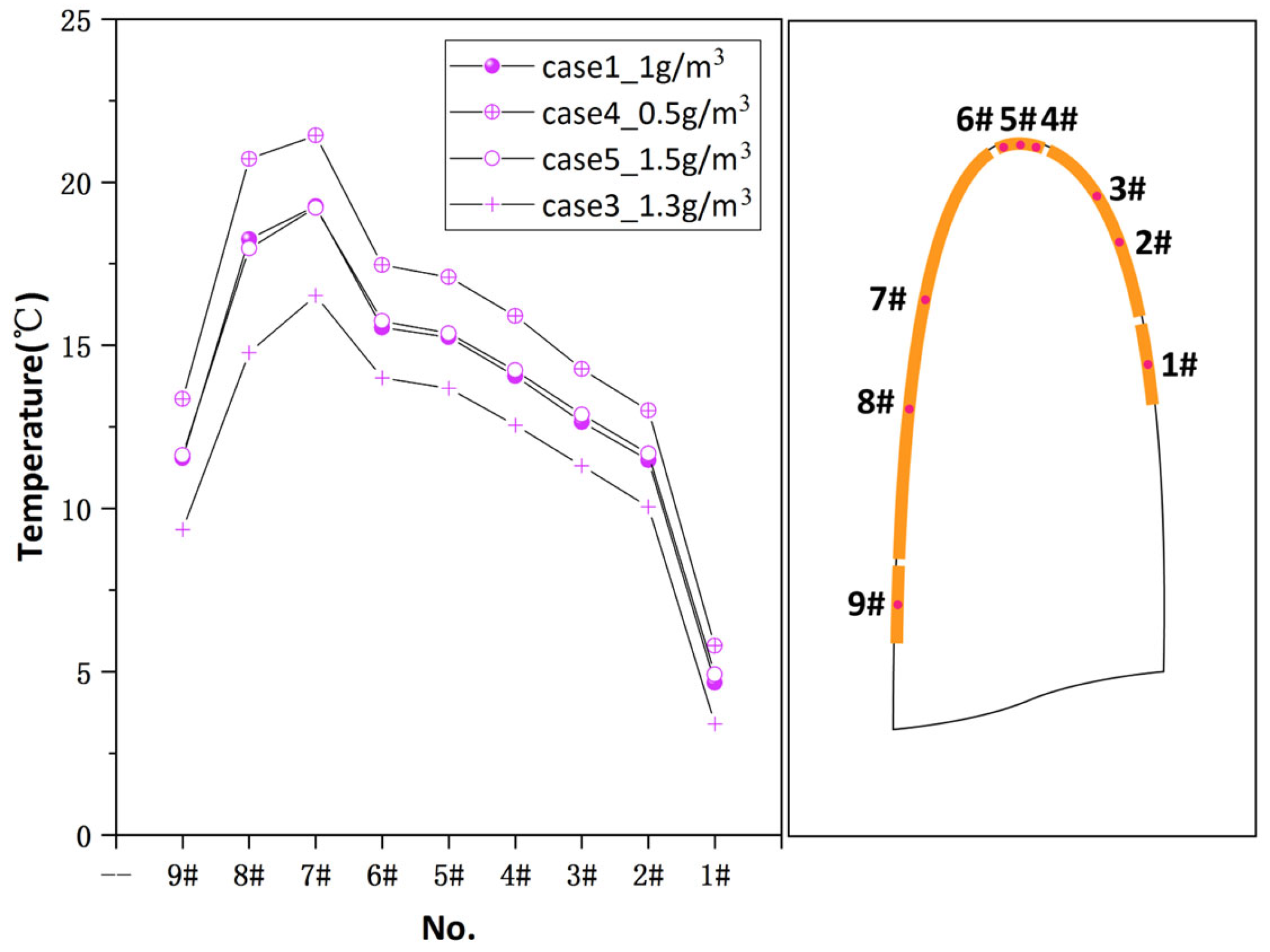

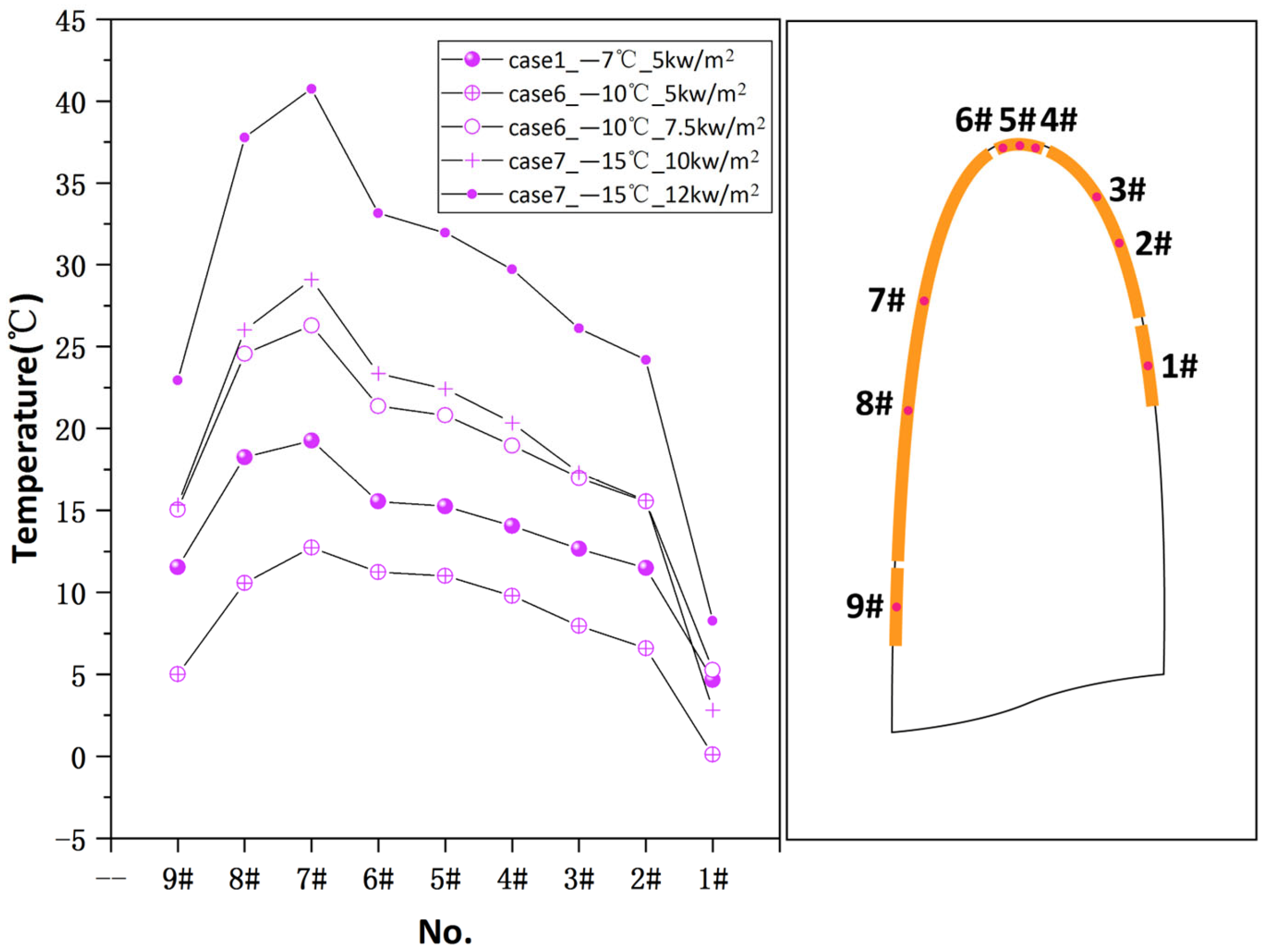

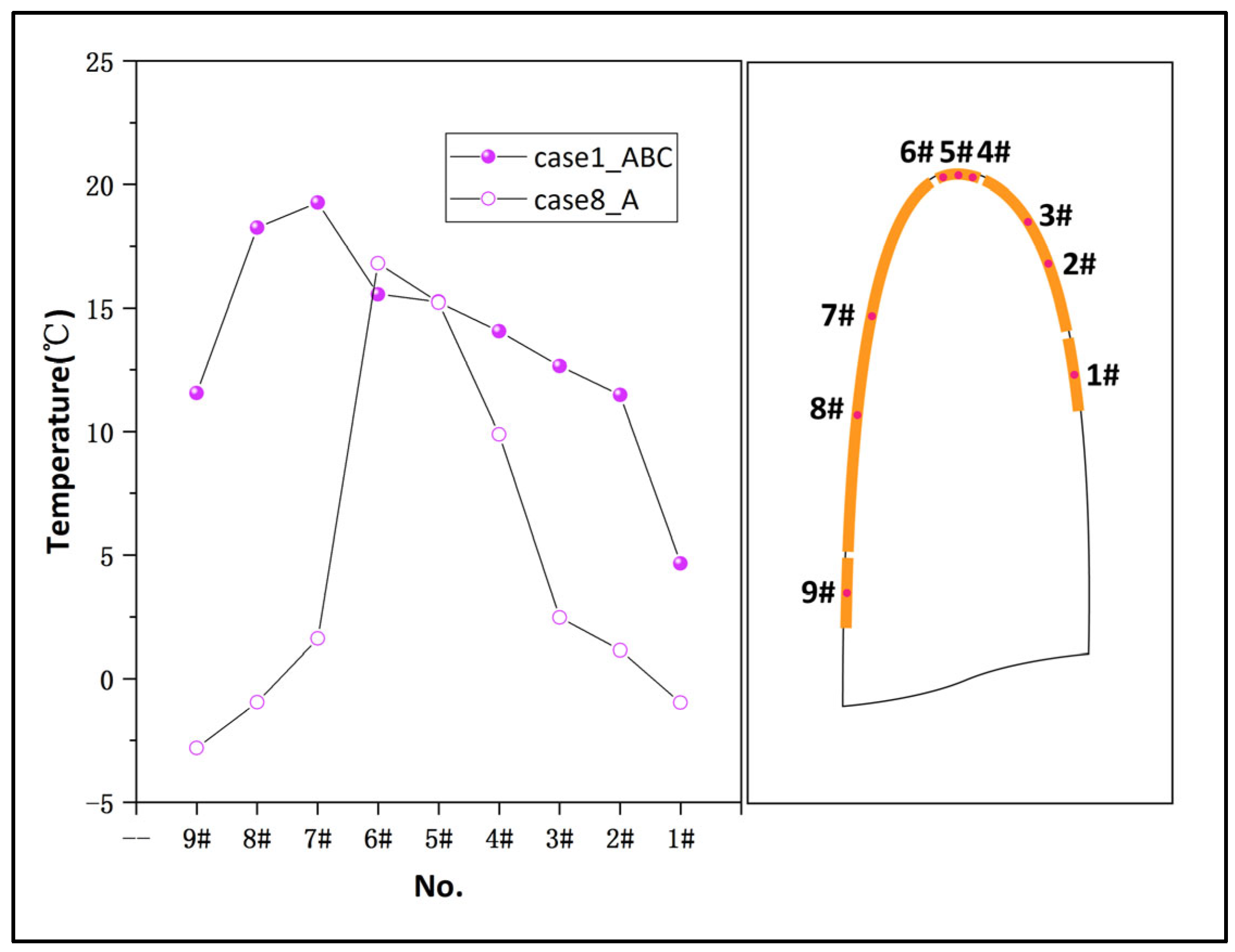
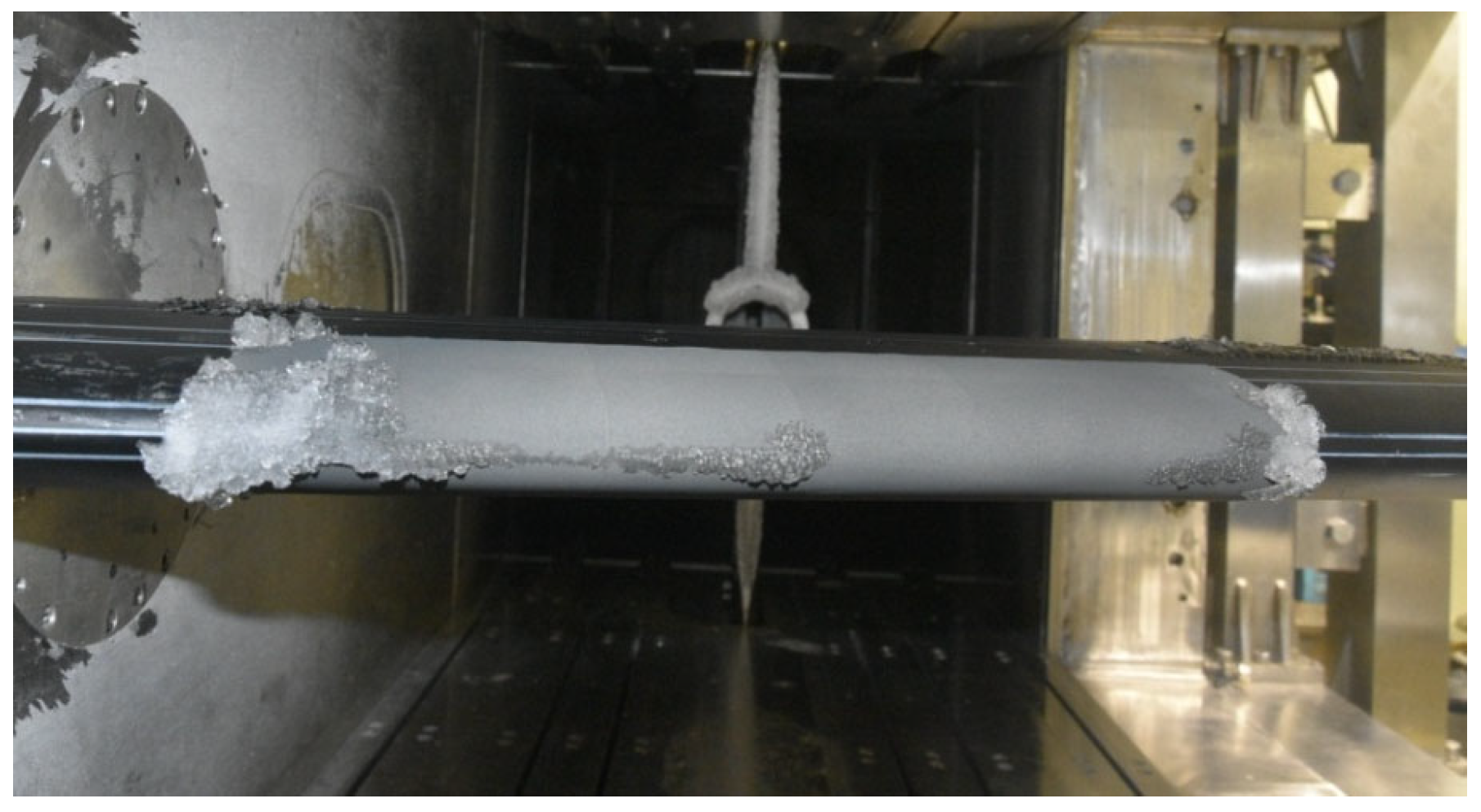
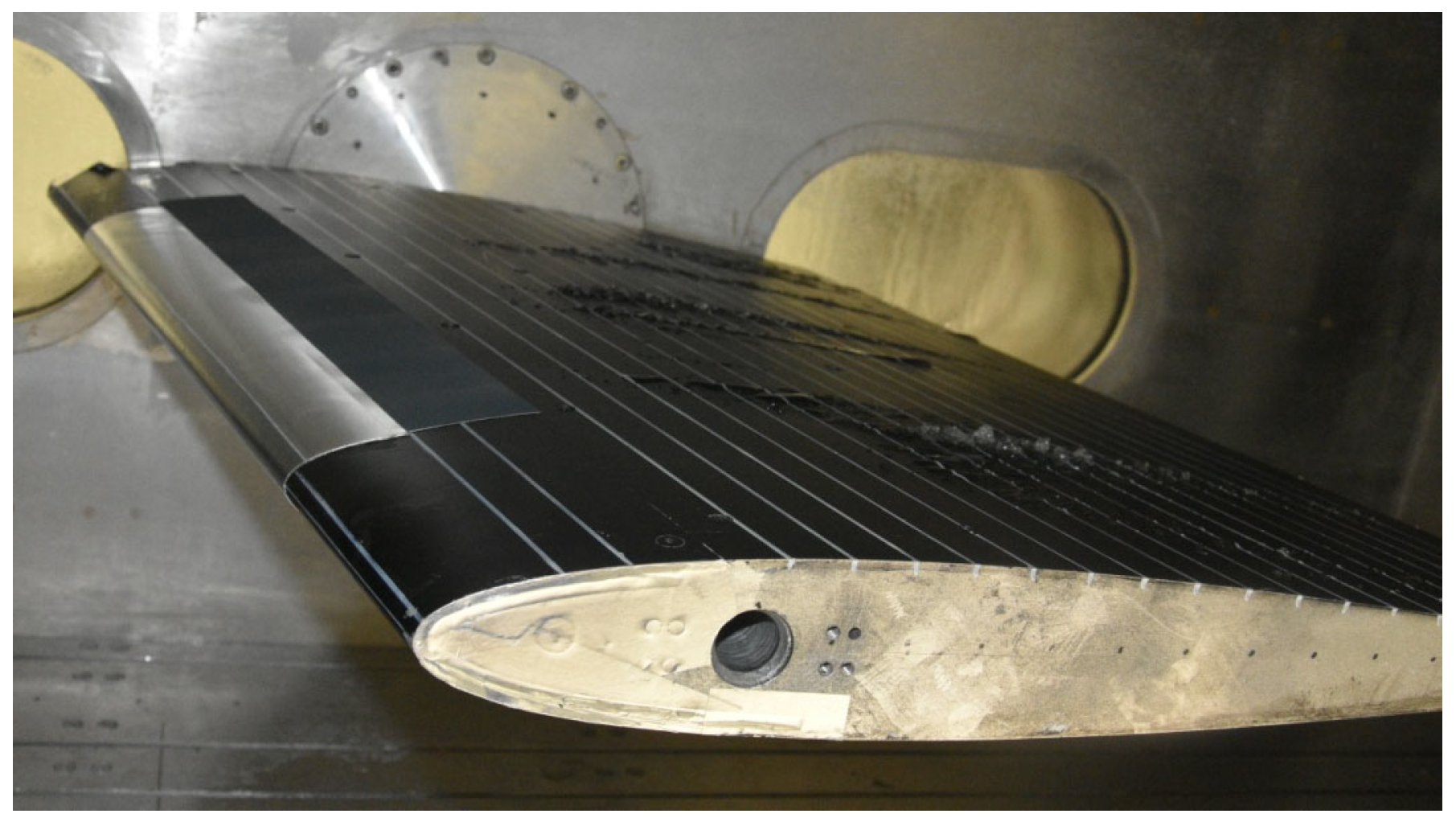
| No. | Arc Length (mm) | Thermocouples Number |
|---|---|---|
| A | 12 | 4# 5# 6# |
| B | 35 | 2# 3# |
| C | 80 | 7# 8# |
| D | 20 | 1# |
| E | 20 | 9# |
| No. | 1# | 2# | 3# | 4# | 5# | 6# | 7# | 8# | 9# |
|---|---|---|---|---|---|---|---|---|---|
| Arc length from the leading edge (mm) | 51 | 31 | 21 | 3 | 0 | 3 | 36 | 61 | 101 |
| Case | MVD μm | LWC g/m3 | Temperature °C | Heating Power Density kW/m2 |
|---|---|---|---|---|
| 1 | 20 | 1 | −7 | 5 |
| 2 | 30 | 1 | −7 | 5 |
| 3 | 40 | 1.3 | −7 | 5 |
| 4 | 20 | 0.5 | −7 | 5 |
| 5 | 20 | 1.5 | −7 | 5 |
| 6 | 20 | 1.5 | −10 | 5 & 7.5 |
| 7 | 20 | 1.5 | −15 | 10 & 12 |
| Case/Type | Heating Power W | Heating Power Density kW/m2 | Coating Area | ||||
|---|---|---|---|---|---|---|---|
| Sheet A | Sheet B | Sheet C | Sheet D | Sheet E | |||
| 8/type (2) | 150 | × | × | × | × | 21 | A B C |
| 9/type (3) | Goes from high to low, details shown below | A B C D E | |||||
| 10/type (4) | 72 | 210 | 510 | 120 | 120 | 10 | D E |
| Case\Temp (°C) | Heating Power W | Heating Power Density kW/m2 | Valid or Invalid | ||||
|---|---|---|---|---|---|---|---|
| Sheet A | Sheet B | Sheet C | Sheet D | Sheet E | |||
| Case 1\−7 °C | 36 | 105 | 255 | × | × | 5 | Valid |
| Case 6\−10 °C | 36 | 105 | 255 | × | × | 5 | Invalid |
| Case 6\−10 °C | 54 | 158 | 383 | × | × | 7.5 | Valid |
| Case 7\−15 °C | 72 | 210 | 510 | × | × | 10 | Invalid |
| Case 7\−15 °C | 87 | 252 | 612 | × | × | 12 | Valid |
| Heating Power W | Total Power W | Heating Power Density kW/m2 | Valid or Invalid | |||||
|---|---|---|---|---|---|---|---|---|
| Sheet A | Sheet B | Sheet C | Sheet D | Sheet E | ||||
| 1st try | 36 | 105 | 255 | 60 | 60 | 516 | 5 | Valid |
| 2nd try | 33 | 95 | 230 | 54 | 54 | 466 | 4.5 | Valid |
| 3rd try | 29 | 84 | 204 | 48 | 48 | 413 | 4 | Invalid |
| Case 1 (reference) | 36 | 105 | 255 | × | × | 396 | 5 | Valid |
Disclaimer/Publisher’s Note: The statements, opinions and data contained in all publications are solely those of the individual author(s) and contributor(s) and not of MDPI and/or the editor(s). MDPI and/or the editor(s) disclaim responsibility for any injury to people or property resulting from any ideas, methods, instructions or products referred to in the content. |
© 2023 by the authors. Licensee MDPI, Basel, Switzerland. This article is an open access article distributed under the terms and conditions of the Creative Commons Attribution (CC BY) license (https://creativecommons.org/licenses/by/4.0/).
Share and Cite
Yu, L.; Wu, Y.; Zhao, H.; Zhu, D. A Study on the Sensitivities of an Ice Protection System Combining Thermoelectric and Superhydrophobic Coating to Icing Environment Parameters. Appl. Sci. 2023, 13, 6607. https://doi.org/10.3390/app13116607
Yu L, Wu Y, Zhao H, Zhu D. A Study on the Sensitivities of an Ice Protection System Combining Thermoelectric and Superhydrophobic Coating to Icing Environment Parameters. Applied Sciences. 2023; 13(11):6607. https://doi.org/10.3390/app13116607
Chicago/Turabian StyleYu, Lei, Yuan Wu, Huanyu Zhao, and Dongyu Zhu. 2023. "A Study on the Sensitivities of an Ice Protection System Combining Thermoelectric and Superhydrophobic Coating to Icing Environment Parameters" Applied Sciences 13, no. 11: 6607. https://doi.org/10.3390/app13116607
APA StyleYu, L., Wu, Y., Zhao, H., & Zhu, D. (2023). A Study on the Sensitivities of an Ice Protection System Combining Thermoelectric and Superhydrophobic Coating to Icing Environment Parameters. Applied Sciences, 13(11), 6607. https://doi.org/10.3390/app13116607






